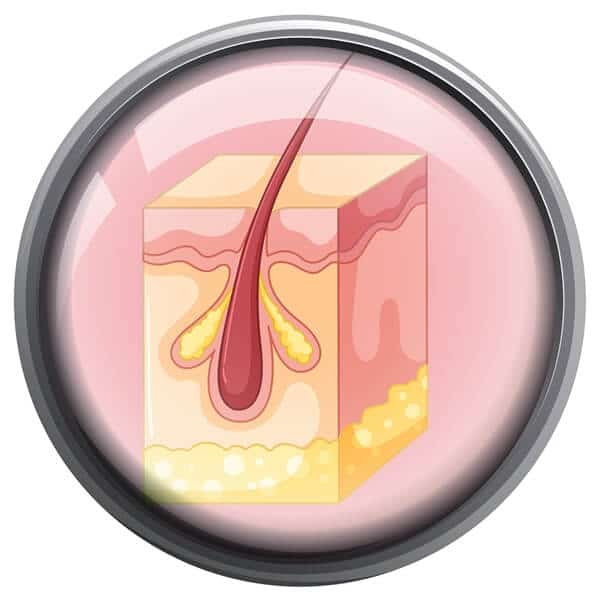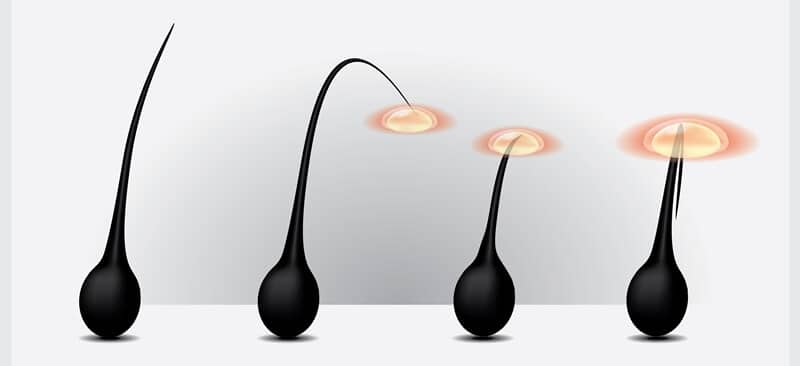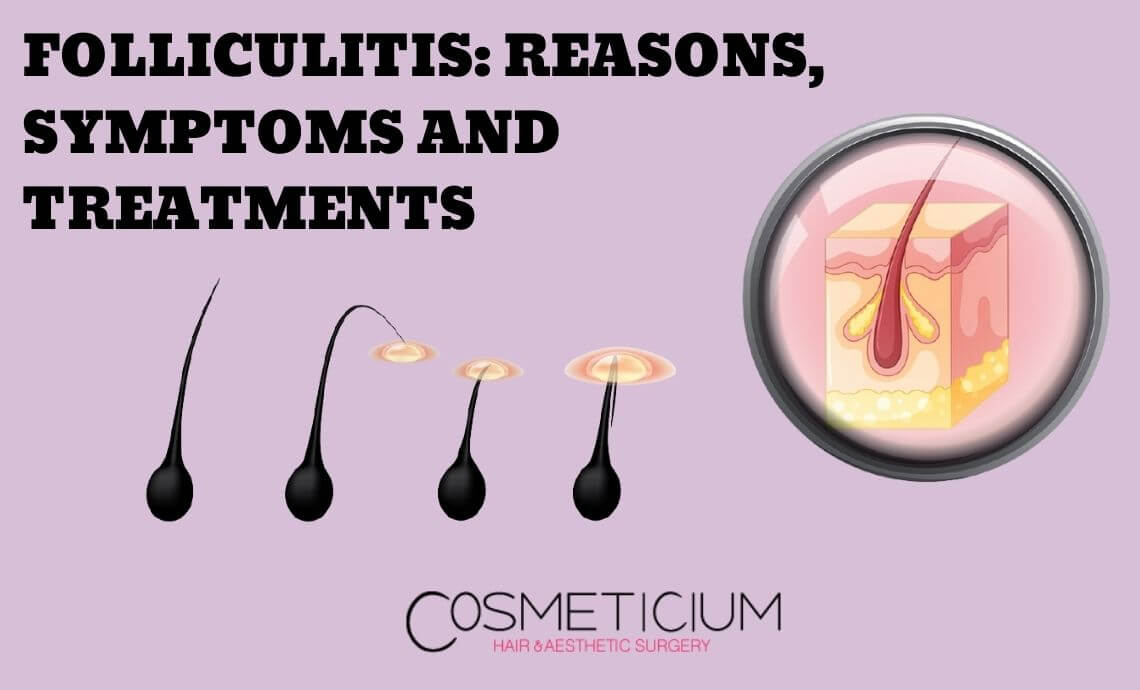There may be different effects on hair by external factors throughout a day. Different factors like pollution, cosmetic products used and wrong hair care affect scalp bad. Among these factors, there are bacteria and microbes as well. Microbes and bacteria may cause different problems on scalp. One of them is folliculitis, also known as scarring alopecia – in other words, hair follicle inflammation. Then, what is folliculitis? What are its reasons and symptoms? Is it contagious? How is it treated? We gathered all answers for you.
Table of Contents
Reasons of Folliculitis
Folliculitis is a rare inflammatory disease that may result in scarring alopecia. It is seen among young men in general. Yet, it shouldn’t be forgotten that it can be seen among women as well.
Hair follicle inflammation can be explained as an immune system reaction that causes scalp fibrosis. Fibrosis that occurs in this case may cause permanent hair loss.
Despite these critical effects, certain reasons for this disease are still unknown. But, inside scalp samples obtained from people with this disease, a bacteria known as staphylococcus aureus was found. Therefore, it is thought that this bacteria may be the reason of this disease.
This bacteria, which is no commensal on scalp, may cause inflammation in follicles. Due to immunological response to this inflammation situation, folliculitis may occur.
There are some situations that contributes to this inflammation case. Trauma, sweating, clogged pores and untreated scars make everything easy for inflammation.

Symptoms
Symptoms of folliculitis are very clear. It is possible to diagnose this disease even in its initial phase.
- Initially, redness occurs around follicles.
- This redness causes pustule formation (pustule is dermatologic lesions that contain pus)
- Pustules go on developing in time and they decompose during scab formation. This way, infected and inflammatory follicles cause alopecia.
Among folliculitis symptoms, there are itching and pain as well, except redness and pustule formation. Pain and itching may not be common for everyone, but if these are seen together with redness in follicles, folliculitis should be the first probability.
Is Folliculitis Contagious?
This disease is closely related with staphylococcus infection. Therefore, it is possible for this disease to be contagious. It is very probable that infection occurs between follicles. It should also be remembered that person to person infection is possible.
With some simple precautions, you can eliminate infection risk considerably. Especially liquid hygiene precautions have high importance. You can eliminate this risk with regular hand washing, not using common towels and disinfecting any equipment related with hair.
People with weak immune system, children and pregnant women must implement these precautions. Folliculitis is a chronic inflammatory disease. Depending on the methods applied during treatment, there are risks of repetition and inflammation.
How Is It Treated?
As in all diseases, early diagnosis is very crucial. Yet, today, there is still no certain treatment for this disease. With the treatments shared below, lesion development can be slowed down or stopped completely. Besides, risk of repetition is also prevented. Here are some methods used to treat folliculitis:

Antibiotics Treatment
The first treatment method for hair follicle inflammation is using antibiotics. Yet, during antibiotic selection, staphylococcus sensitivity must be considered. All in all, this bacteria is resistant to antibiotics. At this point, antibiotics like rifampicin, pristinamycin and cyclines can be preferred.
Antibiotics treatment is applied generally for 6 months. The reason behind this long application duration is the risk of repetition. However, despite of this long-term application, the disease may repeat. In such cases, antibiotics used is changed and different medicine is preferred. This decision must be taken by your doctor.
The first preference is generally using cyclines. In case it fails, pristinamycin and rifampicin can be tried. It shouldn’t be forgotten that antibiotics are not innocent medicines and there may be different side effects.
In order to increase the efficiency of antibiotics treatment, oral antibiotics like fucidic acid can also be used. This way, a combined treatment is applied.
Related Treatment
During treatment, different application that are related with antibiotics treatment or that are completely independent can be preferred. Isotretinoin application, which is a treatment for severe acne, may be effective in hair follicle inflammation as well. However, this treatment is contraindicate with cyclines. At this point, anti-inflammatory effects of zinc are used. With antibiotics, zinc is also prescribed for 6 months. This way, risk of repetition is reduced.
Surgical Intervention
It is possible for lesions to be treated with this method. However, in order for surgical intervention to take place, the disease must be in an inactive phase. When inflammation is not observed at least for 1 year, the disease is considered as inactive and then surgical intervention can be done.
How Is Folliculitis Prevented At The Outset?
By paying attention to hygiene rules, the risk of this disease can be significantly reduced.
All equipment that touch hair and scalp must be disinfected and belongings like towel and comb must not be shared.
If you have this disease, firstly you must accept the treatment process and follow your doctor’s suggestions and instructions. Trust your doctor and reduce your daily stress level. This way, you can obtain the desired result and overcome negative effects of this disease.
Does Folliculitis Occur in Beard?

Although folliculitis formation is not common in beard area, it is possible. It is generally seen in African male and it is often confused with bacterial folliculitis. Yet, the main reason of this disease at this point is bad beard shaving.
Not shaving hair completely and irritation occurrence may cause this disease. Irritation will result in inflammatory reaction after some time. As a result of this reaction, papule and pustule may occur. In the final stage, scar may form.
In case this disease is seen in beard area, it is suggested to stop shaving. Hot compress is applied and with a sterile needle, ingrown hair is removed. Among these, corticosteroid and prednisone can also be used during treatment.
Read Also: Which Foods Should Be Consumed for Healthy and Strong Hair?
RESULT
Folliculitis is disease seen in hair area and sometimes in beard area. It can be defined as inflammation in hair follicles. Some pharmacological substances are used during treatment and the treatment takes long so that it does not repeat. With early diagnosis and correct applications, effects of this disease can be reduced significantly.

As Cosmeticium, we have expert surgeons and doctors in folliculitis and other scalp diseases. About any problem you experience and related treatments, you can get information from our experienced doctors. In order to benefit from our online consultation service that we offer free of charge, you can contact us.
Fill In The Form Below To Get Answers To All Your Questions About Hair Health From Our Doctors Within Hours. (FREE)

